E. Kristin Anderson's Blog, page 14
November 11, 2014
IT’S HERE! IT’S FINALLY HERE! A JAB OF DEEP URGENCY is out in the wild!
Breaking news! Those of you who pre-ordered A JAB OF DEEP URGENY are receiving your copies in the mail. AND I AM SO EXCITED! This chapbook, like every chapbook, I think, was a labor of love. Perhaps unlike other chapbooks, it exists because of a community of writers that encouraged me to take on a cool found poetry project. And now there’s a book. And it’s really pretty! Check out this picture of fellow Finishing Line poet LaToya Jordan‘s wee daughter holding A JAB OF DEEP URGENCY:
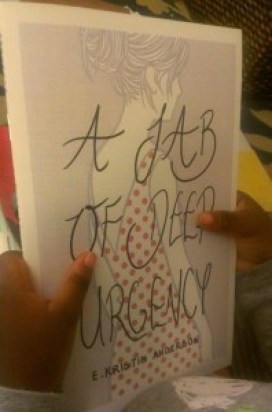
Check out those cutie future-poet hands!
If you haven’t yet ordered a copy, you can do so from my publisher, Finishing Line Press. If you’re local to Texas, I have two upcoming readings and I would love to meet you and read poems to you and sign books for you!
On Saturday, November 15, I’ll be at Malvern Books in Austin, TX. I’ll be reading at 7pm with fellow Austin writer Tatiana Ryckman. There will be snacks and drinks and lots of wonderful words!
On Saturday, November 22, I’ll be at The Book Spot in Round Rock, TX. This will be a celebration of both A JAB OF DEEP URGENCY and my book that came out in June, A GUIDE FOR THE PRACTICAL ABDUCTEE. I’ll be reading from both books and signing and answering questions about found poetry and bumps in the night. Make sure you show up if you’d like to get a mini found poetry kit, which I am joyfully putting together right now!
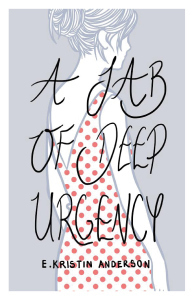
Finishing Line Press, October 2014.
Come hang out! I can’t wait to see y’all!
Very soon reading guides will be available for both books. I’ll have them on my website for educators to download, and I will also have pretty, printed versions at events. Including the above-mentioned events! Thanks to Colleen Conrad of Kealing Middle School for writing these!
And thank you to everyone has encouraged and supported me as a poet and as a writer. Especially my family, the folks at Found Poetry Review, Team Red Bird and Team Finishing Line as well as all my pals here in the Austin Writing Community and my online community at CRLiterature on deviantART.com.
IT’S HERE! IT’S HERE! IT’S HERE! I’m going to go roll around in some poems now. YAY!





November 5, 2014
Review: SERVANTS OF THE STORM by Delilah S. Dawson
Imagine Savannah Georgia.
Now Imagine Savannah Georgia after a devastating hurricane that destroyed neighborhoods, tore down the local amusement park/tourist trap, and broke hearts when it swept loved ones away.
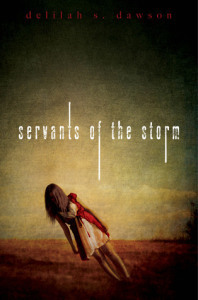
Simon Pulse, August 2014.
Imagine that the Savannah that Hurricane Josephine left behind isn’t just a city cleaning up the wreckage left behind by a natural disaster. Imagine that it’s crawling with demons — demons that nobody can see. Except Dovey. And the demons are willing to do just about anything to keep her from seeing. The water supply is drugged, after all. And she has her pills, prescribed after her breakdown at her best friend Carly’s funeral. At first, Dovey thought that seeing Carly was a fluke — a manifestation of grief. But soon she’s sucked into the seedy underbelly of Savannah, complete with a fox-eared girl and a cute boy who tells her to stay the hell away.
But if the ghostly Carly that Dovey saw can be saved, there’s no way that Dovey is going to stay away. With most of her friends unable to see a thing and her parents now on the drugs that keep them in the dark, Dovey must rely on her wits, the cute new guy with the obvious dark past, a bit of magic from Carly’s granny, and the hope that she can get her other best friend, Baker, can open his eyes enough to see the danger that threatens everyone they love.
Fast-paced and brilliantly plotted, SERVANTS OF THE STORM is a must-read for fans of southern Gothics, folklore, and all things dark and haunt-y. I can’t wait to see what Delilah S. Dawson does next!





November 4, 2014
Review: FLOATING BOY AND THE GIRL WHO COULDN’T FLY by P.T. Jones
This book made me smile. So much. Which might be weird, because it has some pretty dark moments. There’s the floating boy, of course, who is at first debunked as an urban legend before Mary can prove that she saw him, that she isn’t crazy, and if she doesn’t do something, her whole town will be in trouble. There’s the creepy balloon man, the contagion, the small town hysteria, the scary zealots, the asshole jocks and the absent parents. But there’s also the moments of love and friendship and FLOATING BOY AND THE GIRL WHO COULDN’T FLY is a debut YA effort from team P.T. Jones. I’d say it’s a triumph.
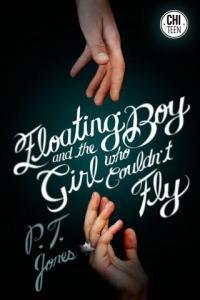
ChiTeen, November 2014.
When Mary first sees Floating Boy at a birthday party for her baby cousin, she comes home to find out that the news has already pegged the incident as mistaken identity — floating boy is nothing more than a gingerbread-man-shaped balloon. But then Mary’s brother starts floating. And before she knows it, she’s busy tying him to his bed and trying to get Floating Boy to tell him why kids all over town are starting to float and the adults are running ridiculous fevers…and running to the ER.
With her bestie Liv and an unlikely team of Allies, it’s soon up to Mary and Floating Boy to confront the reality of the floating crisis. While some of the local teens are more than happy to fly around and party, Mary is the only one of them who has managed to stay grounded. Which means she’s the only one who can save her brother when the crisis goes from something that kind of sucks to something that hits home.
FLOATING BOY AND THE GIRL WHO COULDN’T FLY isn’t the novel I thought it would be. It’s better. It’s more compelling than I could have imagined. With elements of mystery, suspense, romance, mad science and magic realism this is a book that probably has something for everybody. The lyric prose and snarky-loveable protagonist are just the icing on the cake. This is a title to watch this fall. Pick it up. Read it. Hug it. I dare you to resist. (Just kidding. Don’t resist. Just read.)





November 3, 2014
Review: EVIDENCE OF THINGS NOT SEEN by Lindsey Lane
I’ve never read a book quite like the debut novel from Lindsey Lane, EVIDENCE OF THINGS NOT SEEN. I could compare Lindsey to authors like Meg Rosoff and David Levithan, writers who are adept at weaving multiple characters and storylines together to create one fascinating narrative ARC. I could compare her to Rainbow Rowell and Laurie Halse Anderson, who know how to hit you right in the feels, but keep you clutching their books for dear life, begging for more. I could compare her to so many other brilliant writers. But she’s Lindsey Lane. And she does her own thing. And she does it beautifully.
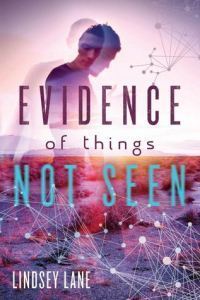
Farrar, Straus and Giroux, September 2014.
EVIDENCE OF THINGS NOT SEEN is the story of a missing boy, Tommy Smythe. Sort of. It’s also the story of a bunch of other people who knew him, had run into him, had heard of him, and could have known him if their paths had crossed in a slightly different way. It’s the story of migrant farm workers and popular girls and nerds and victims of violence and kind strangers and runaways and mechanics and rich kids.
As much as this book is a mystery, it is also an exploration of the human condition, a collection of interconnected short stories that in themselves are each brilliant and lovely, but together, with excerpts from Tommy’s journal and a touch of string theory, EVIDENCE OF THINGS NOT SEEN is a statement. What it says to you is something you’ll have to decide by picking up the book. Which you should. Like, yesterday. This is one of my favorites of the year, and I expect to see it on many awards lists in the near future.





October 21, 2014
Review: ADRENALINE CRUSH by Laurie Boyle Crompton
Dyna is a born daredevil, from an entire family of daredevils. Her older brother Harley is obsessed with skydiving, and her parents are hippie bikers. Her dad is even a famous tattoo-artist, and Dyna can’t wait to get her first tattoo — one to match her other family members’.
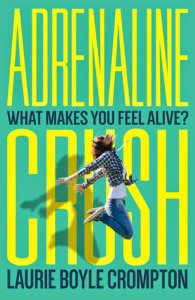
Farrar, Straus and Giroux, September 2014.
Summer break is almost over and Dyna is biking out through the woods near her house when she runs into a cute, straight-laced boy from school. Together, they end up at the swimhole — formerly a quarry — where Dyna finds herself climbing around the surrounding rocks. But things go wrong, and Dyna ends up in the hospital with a shattered ankle. She may never regain full use of that leg. But her new boyfriend stays by her side, and she feels safe and loved. However, her mom insists she start rehab at a local center that does both “inner” and “outer” recovery. As much as she hates the blah-blah-blah of therapy, she finds herself enjoying the company of her recovery group — especially a veteran who seems to enjoy her company as well.
Torn between the nice guy and the guy who understands her longing for adventure, Dyna has choices to make. Not to mention, that ankle of hers — will she ever climb again? Ride a bike? Run? Her life has changed forever, and if she wants any control over it, she’s going to have to learn to take the reins.
Written with a strong sense of voice and tight prose, ADRENALINE CRUSH by Laurie Boyle Crompton is an absolute must for contemporary YA fans. While perhaps the material is not as intense as, say, SPEAK or WINTERGIRLS, Crompton‘s writing style is on par with Laurie Halse Anderson’s, with characters that shout from the pages and come to life. Don’t miss this exciting new book this fall — it’s a good one.





October 20, 2014
Review: PLAY ME BACKWARDS by Adam Selzer
Full disclosure: Satan may or may not be a major character in this book. This will either hook you or turn you off immediately. For me, it was a hook.
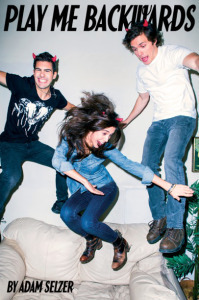
Simon & Schuster Books for Young Readers, August 2014.
Adam Selzer‘s latest takes place in his fictional Des Moines suburb of Cornersville Trace (which I lovingly think of as the Selzerverse) — your typical suburban town where nothing cool ever seems to happen (though if you’ve read his other books, you know this isn’t really true) and it’s easy for an outcast to slip through the cracks. PLAY ME BACKWARDS falls the story of one-time kid genius and current slacker extraordinaire Leon Harris. Leon spends most of his time at a seriously podunk ice cream shop that doubles as a hang-out for him and his rag-tag group of weird, not-really-but-kind-of-Satanist friends. Including Stan, of course, who claims to be Satan himself. When Leon gets a message from his old girlfriend — Anna, who broke Leon’s heart when she moved to England and went incommunicado — he is determined to be the guy she left behind. He wants to get his act together, and with the help of Stan, he’s pretty sure he can do it. Of course, the price is his soul and a list of seemingly-absurd Herculean tasks to complete before Anna is supposedly returning to Cornserville.
But, of course, much like in our beloved classics like THE PERKS OF BEING A WALLFLOWER or AN ABUNDANCE OF KATHERINES, this isn’t a story about the journey. This is a story about the characters, about who they are and what they stand for and what they think they stand for and what they will stand for when their eyes open up a little bit. It probably starts when Leon gives a popular cheerleader-type a ride home from a fast food restaurant on Valentine’s Day. There’s also the listening to the complete Moby Dick audiobook, and the yearbook committee, and the big Satanist not-quite-movement at the high school.
As you might imagine, hilarity ensues. Like, the laugh-out-loud kind of hilarity that you’ve come to expect from the Selzerverse. Because nobody does YA satire like Adam Selzer.
Fans of the bildungsroman really need to get their hands on this book. Like, now. It’s twisted and weird and beautiful and funny and even occasionally heart-breaking. This is a don’t-miss book. I take back what I said at the beginning. If Satan as a sidekick turns you off, maybe you should read this book anyway. Because it’s the kind of book that unifies the way WALLFLOWER unifies. It makes you think, it makes you mad, it makes you love. Hey, award committees, put a shiny sticker on this one.





October 8, 2014
7 Questions I Always Ask +1: Shannon Lee Alexander
Today for 7 Questions +1 I have debut author Shannon Lee Alexander, whose new novel (brand new this week!) has been compared to John Green’s THE FAULT IN OUR STARS. YA contemporary fans, LOVE AND OTHER UNKNOWN VARIABLES is probably one you want to get your hands on! Onto the questions:
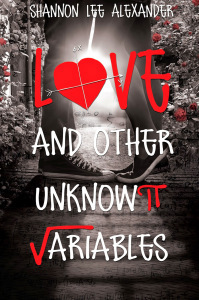
Entangled Teen, October 2014.
E. Kristin Anderson: What was the first spark of inspiration for your latest novel?
Shannon Lee Alexander: I was revising this amazingly crappy manuscript that I should probably delete from my hard drive just so it can’t accidentally leak out, causing me to have to create an elaborate story about possession by an illiterate demon determined to smear my good name, when the voice of this teenage boy cut through the chaos and caught my attention. Charlie Hanson walked into my writing space (which was then a corner of my toy strewn family room), flopped down on the couch near my desk, and started whining to me about his new English teacher.
His voice was so compelling and earnest, how could I not listen?
EKA: What kind of planning do you do before you start writing?
SLA: I didn’t do any planning before writing Love and Other Unknown Variables—at least not any planning on paper. I spent weeks just listening to the character’s voices in my head, trying them out in new situations and seeing how they’d react. Before I started writing, I knew each of their quirks and hopes and needs, but I didn’t know exactly how to get them to the end of the story.
I wrote an entire novel length manuscript about Charlie and Ms. Finch that, essentially, was trashed so I could start over and write the story I was really trying to tell. Planning ahead of time, would have saved me the trouble, but I don’t regret it because in the years it took me to write Love and Other Unknown Variables, I’ve learned so much about not only the craft of writing, but about myself, my strengths and weaknesses.
Now, I make myself write a loose outline to be sure I’m telling the story that needs to be told. I whine an awful lot about making the outlines though. I’m a pretty big baby about planning, but I know it helps me stay on track, so I do it. It’s like eating your vegetables, I guess.
EKA: If you could have lunch with any writer living or dead, who would it be?
SLA: Writers are like rock stars or movie stars to me, so the idea of having lunch with one is really intimidating. I’m pretty sure I’d end up babbling like a crazy woman to quell my anxiety. I’m dating myself here, but remember Molly Shannon’s character on SNL, Mary Katherine Gallagher? That’d totally be me. I guess if I have to choose someone to make a fool of myself in front of, I’d pick Rainbow Rowell because she seems so genuinely nice, and I think that maybe she wouldn’t judge me too harshly.
EKA: What is the first book you remember reading and enjoying as a young reader?
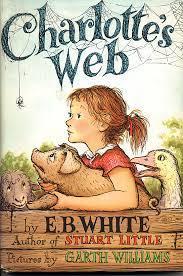
HarperCollins, Reprint Edition, December 2004.
SLA: My second grade teacher was this tiny, African American woman, with a sharp nose and a soft voice. Her name escapes me, but I vividly remember her perching on the edge of her desk to read aloud to us from CHARLOTTE’S WEB. When she read the chapter with (spoiler alert!) Charlotte’s death in it, I remember my eyes got teary and I hid my face in my hands, mortified because I didn’t want my classmates to see me crying over a book. But then I heard this strange warble in the teacher’s voice and when I looked up, she was crying, too. I loved her for that. And to this day, I love that story because it was the first book that showed me how stories can connect us to each other.
EKA: If you could go back and time and tell your teen self ONE THING AND ONE THING ONLY, what would it be?
SLA: Always choose kindness (and that goes for how you treat your hair, too, so walk away from that spiral perm, young Shannon! Walk away).
EKA: If you haven’t had a book challenged or banned, would you want this to happen to you? Why or why not?
SLA: I’d LOVE to have my book honestly challenged, and by that I mean the challenger had actually read the book prior to issuing the challenge. At least I’d know it had sparked some emotional reaction in someone. That’s one of the goals of sharing your writing, to make other people feel something.
EKA: What kind of book do you really want to try to write, but haven’t ever attempted? And what do you think is holding you back?
SLA: I’d love to write a fantasy novel. I even have characters and pieces of the story mapped out in my mind or on scraps of paper. Fear is holding me back because to write fantasy well, you have to be a world builder. You have to be comfortable creating your own universe and the rules under which it’s governed. And you have to push limits. I’m still figuring out the rules of the world I live in. I can’t imagine coming up with my own! And I’ve never been one to push limits. I’m more of a nudger by nature.
One day, though, one day, I’ll scare up enough courage to do write that story.
EKA: A lot of teens seem to hate math. (I hated math as a teen myself.) What made you want to include math as part of your story? Do you think that your characters might make math less scary for math-fearing teens?
SLA: I didn’t want to include math as part of the story, but Charlie was adamant about his love for it. Like you, I hated math as a teen. I’d hated it since the fourth grade when my math teacher said I was dumb because I sucked at taking the timed multiplication tests every week.
As I got older, I was in advanced classes, so I was obviously not the idiot my fourth grade teacher said I was, but I mostly sat in the back of the room and tried to blend in. Math was for boys. Math was for geeks. Math was for kids whose brains worked differently than mine. All of this, I’d tell myself just before sneaking my novel out of my desk and hiding it in my math book. I was drawn to the arts, writing and drama specifically, and considered math too “right brained” for myself. But really, I was afraid to fail again.
I grew up thinking I could either be good at math or good at English. I could be logical or idealistic. I could go left or right. I could go north or south. What I discovered while writing Charlie and Charlotte’s story is that math and art aren’t polar opposites. They are really two sides of the same coin. Or Charlie would say they are like complementary angles (warning: REALLY bad math joke—math and art are complementary because when you add them together you don’t get a wrong; you get a right—feel free to groan now).
Mathematicians, scientists, and artists are all trying to understand the essence of the universe. They just use different mediums. Once I realized how interrelated they are, I could see beauty in both math and art. And that made math seem a lot less foreign and a lot less scary to me. I hope that when people read Love and Other Unknown Variables they can see that too.
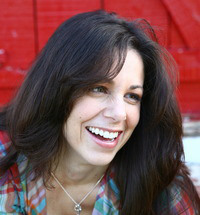
Shannon Lee Alexander.
Shannon Lee Alexander is a wife and mother (of two kids and one yellow terrier named Harriet Potter). She is passionate about coffee, books, and cancer research. Math makes her break out in a sweat. LOVE AND OTHER UNKNOWN VARIABLES is her debut novel. She currently lives in Indianapolis with her family.
Twitter
Facebook
Website
Goodreads





October 3, 2014
Review: GABI, A GIRL IN PIECES by Isabel Quintero
What’s not to love about GABI, A GIRL IN PIECES? Not much that I can think of. This new book by Isabel Quintero is sassy, funny, heart-felt, heartbreaking, hearwarming, and unputdownable. I love Gabi Hernandez, the protagonist, not for her self-deprecating humor, but for her willingness to grow past it. I loved her honesty, as she struggles with some pretty tough stuff, from being the “fat girl” to her best friend’s unwanted pregnancy to her dad being a meth addict. It’s not that she takes it in stride, but that she takes it, and survives it, and does it in style.
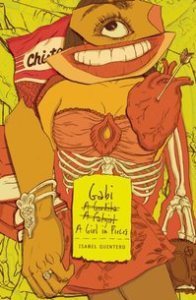
Cinco Puntos Press, October 2014.
Gabi Hernandez is starting her senior year with a lot on her plate. Aside from the aforementioned drama, one of her besties has just come out to his family is gay, and he’s been kicked out of his house. She’s trying to figure out how to find a guy to kiss, and as soon as she gets someone to like her, he turns out to be kind of a weirdo. And while she’s kicking butt in her poetry class, that class is forcing her to confront her issues with her family. Her mom is never shy about telling Gabi to drop a few pounds, which means shopping for a prom dress sounds like the absolute worst. Plus, if she flunks Algebra II again, her chances of getting into her dream school — Berkley — are down the drain.
With a voice that is reminiscent of A.S. King and Hannah Moskowitz, written in journal format and sprinkled with Gabi’s poetry, this is definitely the kind of book that fans of fearless, “edgy” YA will devour.





September 30, 2014
Banned Books Month: Guest Post from Lauren Myracle: Oh good Lord. Again?!
Oh good Lord. Again?! That’s what I thought after reading a recent article in which I was called out—in an inflammatory and slut-shaming way—for using the word “queef” when addressing an audience of high school students.
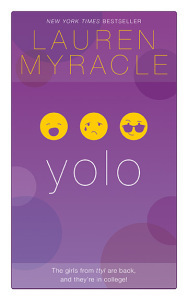
Harry N. Abrams, August 2014.
High schoolers, raise your hands: Who knows what a queef is?
High schoolers, raise your hands again: Do you think a queef—or a fart, or a burp or a yawn or a hiccup—is so shocking that it’s dangerous to even talk about it?
Yeah, me neither. But clearly, some people do.
FADE IN:
INT. CHURCH BASEMENT – DAY
LAUREN walks to a podium at the front of the room and faces a group of adults seated in folding chairs.
LAUREN
Um, hi. My name is Lauren Myracle, and I write about queefs. I also write about tampons, and sex, and bras and thongs and the occasional penis.
I write about other things too.
Like love.
And friendship.
And thinking for yourself and trying not to be a dumbshit, because life is a gift and we should do our best to honor it.
Lauren looks at audience. Some adults nod. Others tsk. A scowling woman rises and cups her hands around her mouth.
SCOWLING WOMAN
(yelling)
Boo! Boo! Rubbish!
Lauren furrows her brow. She opens her mouth to respond, but SUSAN, Lauren’s wise and level-headed editor, approaches from stage right and intervenes.
SUSAN
(whispering)
Lauren, I understand that you’re fed up. I do. But you know as well as I do that it’s not fair to characterize all would-be book banners as nut jobs.
LAUREN
It’s not?
SUSAN
(patiently)
Lauren…
LAUREN
(not so patiently, though she knows Susan is right)
Susan…
Susan rubs Lauren’s shoulders. Lauren sighs.
LAUREN (CONT’D)
Fine. Yes. Most adults who want to keep books from shelves are acting out of concern for their kids, and I get that. They’re scared. They want to keep their kids safe. It’s just…
SUSAN
Go on. Get it out.
LAUREN
I thought I was over having my feelings hurt about this stuff. Turns out I’m not, that’s all. Because I’m not trying to corrupt kids. I love the kids I write for, and when adults—as well-intentioned as they may be—try to keep kids in the dark, I feel like it’s a huge disservice to the very kids they’re hoping to protect. Plus, it’s incredibly condescending to assume that kids can’t think critically about what they read.
SCOWLING WOMAN
(pointing at Lauren)
Filth! Slime! Satan’s minion! Boo!!!!
Lauren bows her head.
LAUREN
Oh, Susan. Today I’m sad, but tomorrow I’ll rally. Okay? To those of you fighting the good fight against censorship, thanks for keeping the faith. And to those of you just joining the discussion, please know that in the long run, it’s all going to be okay. In my heart of hearts, I do believe that.
So, you know, be swift to love, make haste to be kind, and treat others with respect, regardless of their age. Let kids read what they want to read, because kids do have brains. Good ones. I vote for letting them use them.
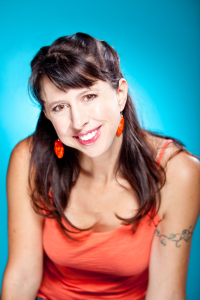
Lauren Myracle.
Lauren Myracle is the author of the New York Times bestselling Internet Girls series (ttyl, ttfn, and l8r, g8r), THE INFINITE MOMENT OF US, SHINE, RHYMES WITH WITCHES, BLISS, and the Flower Power series, among many other books for teens and young people. In yolo, the recently published fourth book in the Internet Girls series, the winsome threesome are back and they’re taking college by text! Lauren lives with her family in Fort Collins, Colorado. Visit her online at laurenmyracle.com.





September 29, 2014
Banned Books Month: Guest Post from Karen Harrington: You’re going to allow your daughter to read THAT?
I’m the author of a book in which Harper Lee’s TO KILL A MOCKINGBIRD looms large over the story. I shudder to think what would become of my twelve-year-old protagonist, or myself, if we hadn’t discovered Atticus Finch at the exact right moment in our lives. Atticus revealed himself as the kind of parent few have, but most crave.
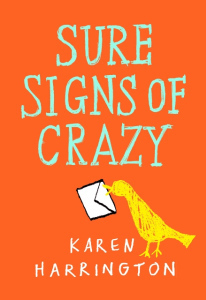
Little, Brown Books for Young Readers, August 2013.
I wish I’d thought about writing letters to Atticus, as my character Sarah, does so earnestly in an effort to understand her troubled world – a world where adult problems like alcoholism and mental illness and unrequited love are visiting her young life far too soon.
But that’s the thing about good fiction. Fiction tells stories about messy lives and messy problems.
That’s what made me love TO KILL A MOCKINGBIRD. When worldly problem visited me, I took courage from a wise man named Atticus who didn’t hide truths from his children.
“Scout,” said Atticus, “when summer comes you’ll have to keep your head about far worse things…it’s not fair for you and Jem, I know that, but sometimes we have to make the best of thing, and the way we conduct ourselves when the chips are down – well, all I can say is, when you and Jem are grown, maybe you’ll look back on this with some compassion and some feeling that I didn’t let you down.” (TKAM, ch 11)
The whole idea of banning books, especially for teenagers, mystifies me. We do not have the power to ban the real problems of life. So why would we ban a book that features a character surmounting the real problems of life? Don’t we need to see examples of overcoming? A headlight down the road, so to speak?
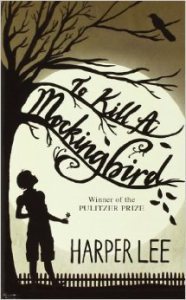
Grand Central Publishing, Mass Market Edition.
Now, I wonder at the possibility of TO KILL A MOCKINGBIRD being published in 2014. Prior to the publication of my book, SURE SIGNS OF CRAZY, it was scrubbed of any curse words, a scene in which the main character takes a sip of alcohol and the use of the word “tongue” to describe a French kiss. (That last edit took some linguistic gymnastics, I tell you!)
Of course, I understood the reasons for these edits. (In truth, I wrote the story believing it would be for an older audience.) Since its publication, I’ve had many people remark that the references to Atticus will be lost on young readers and go over their heads.
Not so. I get letters from young readers who tell me they look forward to reading the book; that the introduction to Atticus makes them want to know more about him. I love it when one book leads a young reader to another book!
I hope that as readers of SIGNS grow, they won’t be banned from reading about Scout and Atticus.
I get that there should, and will always be, spirited discussions about literature and mature content and age appropriateness. I’m not only a writer, but the mother of two young kids. What’s great about being an author/mom is that books are part of my parenting tool-box to grow mature, thinking, creative adults. I’m of the mind that I’ll factor in my kids’ maturity level and read what their reading or want to read ahead of time before making any kind of hullaballoo. In other words, take it one book at a time before exercising any personal book banning.
But there’s one kind of subtle book banning I didn’t see coming in my author/mom journey.
The kind that’s implied when I have this exchange:
“Wait, you’re letting your own daughter read THAT book?”
“Yes.”
Here, I want you to imagine the use of the word THAT as if someone was looking at a piece of moldy bread and someone said, “You are letting your daughter eat THAT sandwich?”
Thanks to author John Green, I’ve gotten these comments a lot this summer, all because I allowed my eleven year-old to read THE FAULT IN OUR STARS.
Now, at the end of my daughter’s fifth grade year, there were lots of girls frothing at the mouth to read THE FAULT IN OUR STARS. I recognized that a fair amount of them just wanted to be able to say they’d read the book meant for older readers that included “mature content.” Anything that remotely hints at being for older kids is almost irresistible to rising sixth graders. The world is starting to open up at this age and they know it!
“Jem assured me that the older I got the better school would be, that he started off the same way, and it was not until one reached the sixth grade that one learned anything of value.” (TKAM, ch. 7)
Because my daughter is a diverse and eager reader AND a sixth grader (do NOT get in her way on Readers’ Digest delivery day!), I wondered if she’d get the fever to read this book.
She did.
This was the first moment in my parenting life that I paused to consider if I’d say no to a book. I hadn’t before. What were my personal beliefs on when a book was appropriate?
One of my initial thoughts was to think of one of my brightest friends. She grew up reading lots of serious, mature and banned literature at the age of ten. She is one of the most intelligent, open-minded, caring, creative adults I’ve ever known. Oh, and also, she is no longer age ten! So, I reasoned, I would like to raise such a person.
So I said, “Yes, you may read that book. I’ve read that book and then we can have a discussion about it after. Okay?”
“Okay.”
And then the moldy bread comments came to me. “You are letting your daughter read that?”
Yes. Yes, I did. What struck me most is that this is the age where institutions like schools and churches are encouraging parents to prepare our young people for the process of growing up, physically and emotionally. In fact, this “begging for the John Green book” came about around the time her elementary school did a opt in/opt out presentation for its students about their growing bodies and upcoming body changes. And about the time our church encouraged parents to talk about sex. And about the time my third grader came home telling me about the swear words someone had carved into the playground equipment and “Mr. K had to paint over them and what does that word mean, mama, and Cory said he knew what sex means. What does it mean?”
Life, huh? The life of a parent means answering these questions while you are just folding clothes and watching Dancing With the Stars.
Life beats on and in directions we are often unprepared for, right? You still have to answer the uncomfortable question now and again.
“When a child asks you something, answer him, for goodness’ sake. But don’t make a production of it. Children are children, but they can spot an evasion quicker than adults, and evasion simply muddles ‘em,” said Atticus. (TKAM, ch. 9)
So why, then, should reading books that deal with the process of growing up be avoided if we are, in fact, teaching them about growing up?
Because it’s hard.
It’s hard to have these discussions. It’s hard to see your child with one foot on the playground and one foot about to step into the real world. But we shouldn’t shy away from hard conversations. As the saying goes, we are raising adults, not kids.
THE FAULT IN OUR STARS turned out to be one of the best discussion tools I could have imagined to talk about all the things I DIDN’T want to talk about. The content of STARS deals with mature content all right. But reading and discussing the book together allowed me to have a conversation with my daughter in a less abstract way. We went so far as to talk about what kinds of choices SHE would make. We talked about how she’ll encounter other characters and real live people who might make painful or harmful choices. We talked about why books are so good because you can learn and experience without having to go through the pain.
I’ve come to this conclusion. I’m still going to take it one book at a time. I’m still going to read what my kids are reading. (This is SO important!) But the next time I receive the commentary about the books I choose to share with my girls, I think I’ll smile and remember some good life advice. Some advice I received, by the way, from the pages of a banned book.
“They’re certainly entitled to think that, and they’re entitled to full respect for their opinions,” said Atticus, “but before I can live with other folks I’ve got to live with myself. The one thing that doesn’t abide by majority rule is a person’s conscience.” (TKAM, ch. 11)
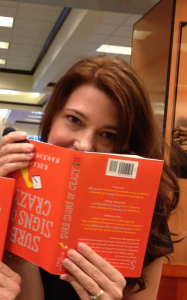
Karen Harrington.
Karen Harrington is the author of SURE SIGNS OF CRAZY (2013) and COURAGE FOR BEGINNERS (2014), both from Little, Brown. She currently lives in Dallas, TX with her family. You can find her at www.karenharringtonbooks.com









